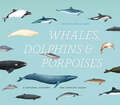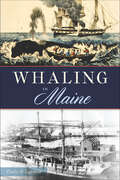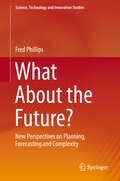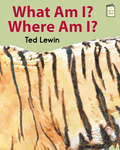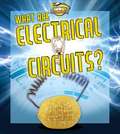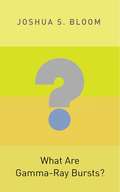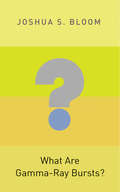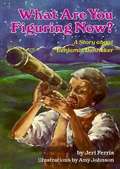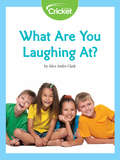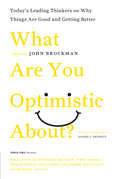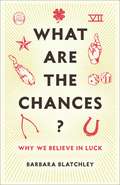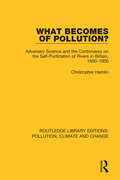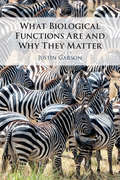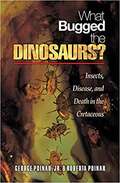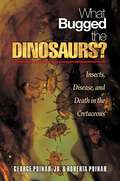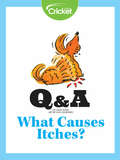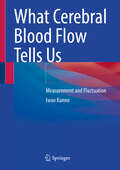- Table View
- List View
Whales of the World
by W. Nigel BonnerInformative and readable survey of the cetacean species; clear, accurate, and uncomplicated by excessive technical terminology.
Whales, Dolphins & Porpoises: A Natural History and Species Guide
by Annalisa BertaThe eighty-nine cetacean species that swim our seas and rivers are as diverse as they are intelligent and elusive, from the hundred-foot-long, two-hundred-ton blue whale to the lesser-known tucuxi, ginkgo-toothed beaked whale, and diminutive, critically endangered vaquita. The huge distances these highly migratory creatures cover and the depths they dive mean we catch only the merest glimpses of their lives as they break the surface of the water. But thanks to the marriage of science and technology, we are now beginning to understand their anatomy, complex social structures, extraordinary communication abilities, and behavioral patterns. In this beautifully illustrated guide, renowned marine mammalogist Annalisa Berta draws on the contributions of a pod of fellow whale biologists to present the most comprehensive, authoritative overview ever published of these remarkable aquatic mammals. Opening with an accessible rundown of cetacean biology—including the most recent science on feeding, mating, and communication—Whales, Dolphins, and Porpoises then presents species-specific natural history on a range of topics, from anatomy and diet to distribution and conservation status. Each entry also includes original drawings of the species and its key identifiers, such as fin shape and color, tooth shape, and characteristic markings as they would appear both above and below water—a feature unique to this book. Figures of myth and—as the debate over hunting rages on—figures of conflict since long before the days of Moby-Dick, whales, dolphins, and porpoises are also ecologically important and, in many cases, threatened. Written for general enthusiasts, emergent cetacean fans, and biologists alike, this stunning, urgently needed book will serve as the definitive guide for years to come.
Whales, Whaling, and Ocean Ecosystems
by Terrie M. Williams Douglas P. Demaster Daniel F. Doak Robert L. Brownell Jr. James A. EstesThis unprecedented volume presents a sweeping picture of what we know about the natural history, biology, and ecology of whales in the broad context of the dynamics of ocean ecosystems. Innovative and comprehensive, the volume encompasses multiple points of view to consider the total ecological impact of industrial whaling on the world's oceans. Combining empirical research, ecological theory and modeling, and historical data, its chapters present perspectives from ecology, population biology, physiology, genetics, evolutionary history, ocean biogeography, economics, culture, and law, among other disiplines. Throughout, contributors investigate how whaling fundamentally disrupted ocean ecosystems, examine the various roles whales play in food webs, and discuss the continuing ecological chain reactions to the depletion of these large animals. In addition to reviewing what is known of the current and historic whale populations, Whales, Whaling, and Ocean Ecosystems considers how this knowledge will bear on scientific approaches to conservation and whaling in the future and provocatively asks whether it is possible to restore ocean ecosystems to their pre-whaling condition.
Whaling Season: A Year in the Life of An Arctic Whale Scientist (Scientists in the Field)
by Peter LourieIt's late April in Barrow, Alaska, which is about as far north in Alaska as you can get. The call comes in over the two-way radio - a crew has caught the first whale of the spring whaling season. Men, women, and teenagers jump on snow machines and drive out onto the ice to help harvest the whale, a tradition the Inupiaq Eskimos on Alaska's North Slope have followed for over two thousand years. John Craighead George, or Craig as he's called, heads out too. He is an Arctic whale scientist, and out on the ice with the whales and the whalers is just one of the places where an Arctic whale scientist works. <p><p> He and his colleagues have an agreement with the Inupiat to study these whales, bowheads. He has studied them for nearly thirty years and the mysteries of these large creatures never fail to amaze him. This installment in the Scientists in the Field series takes readers along with Craig, his wife, their colleages, and the Inupiat people as they go out on the ice and harvest whales. Lourie also details the happenings in Craig's ramshackle lab where he studies various organs and body parts, takes careful measurements, and crunches numbers. This is a real profile of what it is like to be a scientist living where he works, harvesting his own subjects, and using information passed down from generations of Eskimo culture to help him as he becomes the world's leading expert on bowhead whales. <p><p> Craig George is the son of legendary children's author Jean Craighead George, and it is easy to see that Craig grew up in a household where nature and human interaction went hand in hand. Author Pete Lourie's stunning photographs will transport readers to the top of the world, where the days and nights are long, the people respectful, and the whales are at the center of it all.
Whaling in Maine
by Charles H. LagerbomThe history of American whaling is most frequently associated with Nantucket, New Bedford and Mystic. However, the state of Maine also played an integral part in the development and success of this important industry. The sons of Maine became whaling captains, whaling crews, inventors, investors and businessmen. Towns along the coast created community-wide whaling and sealing ventures, outfitted their own ships and crewed them with their own people. The state also supplied the growing industry with Maine-built ships, whale boats, oars and other maritime supplies. For more than two hundred years, the state forged a strong and lasting connection with the American whaling industry. Author and historian Charles Lagerbom reveals why Maine should rightly take its place alongside its more well-known New England whaling neighbors.
What About the Future?: New Perspectives on Planning, Forecasting and Complexity (Science, Technology and Innovation Studies)
by Fred PhillipsThis book closely examines the concept and theory of 'future' from a multidisciplinary perspective, focusing on the practice of forecasting, especially in its interaction with complexity. It highlights the relations between forecasting, decision-making and strategy, mixing technical arguments (but minimal mathematics) with ideas from psychology and philosophy. Rich with examples, the book highlights the role of values and attitudes in deciding how to look at the future. Written in a casual but precise style that makes the ideas easily digestible, it helps corporate strategists, practicing futurists, and researchers in the field of strategy or public planning gain a fundamental perspective on the future – before starting to predict things.
What Am I Made Of?
by David BennettCan anyone explain the human anatomy to a child in such a pleasingly simple and enjoyable style? This book does it!
What Am I? Where Am I? (I Like to Read)
by Ted LewinMajestic paintings by Caldecott Honor winner Ted Lewin illustrate a guessing game that fosters an appreciation of both art and science, while introducing animals in the five major biomes: grassland, desert, forest, tundra, and water. Inspired by his many travels, classically inspired compositions communicate the regal magnificence of five stunning animals: lion, camel, tiger, reindeer, and sea otter. The story ends with a painting of a child and text that reads: I am a boy. I am on the beautiful earth. An I LIke to Read(R) book. Guided Reading Level C.
What Are Electrical Circuits? (Understanding Electricity)
by Ronald MonroeThis comprehensive title introduces readers to current electricity and circuits, the pathways through which electricity flows. Supportive text explains the basic components of an electric circuit and the functions of these parts. Through real-life examples and opportunities for hands-on learning, readers understand and construct simple open, closed, parallel, and series circuits.
What Are Gamma-Ray Bursts?
by Joshua S BloomGamma-ray bursts are the brightest--and, until recently, among the least understood--cosmic events in the universe. Discovered by chance during the cold war, these evanescent high-energy explosions confounded astronomers for decades. But a rapid series of startling breakthroughs beginning in 1997 revealed that the majority of gamma-ray bursts are caused by the explosions of young and massive stars in the vast star-forming cauldrons of distant galaxies. New findings also point to very different origins for some events, serving to complicate but enrich our understanding of the exotic and violent universe. What Are Gamma-Ray Bursts? is a succinct introduction to this fast-growing subject, written by an astrophysicist who is at the forefront of today's research into these incredible cosmic phenomena. Joshua Bloom gives readers a concise and accessible overview of gamma-ray bursts and the theoretical framework that physicists have developed to make sense of complex observations across the electromagnetic spectrum. He traces the history of remarkable discoveries that led to our current understanding of gamma-ray bursts, and reveals the decisive role these phenomena could play in the grand pursuits of twenty-first century astrophysics, from studying gravity waves and unveiling the growth of stars and galaxies after the big bang to surmising the ultimate fate of the universe itself. What Are Gamma-Ray Bursts? is an essential primer to this exciting frontier of scientific inquiry, and a must-read for anyone seeking to keep pace with cutting-edge developments in physics today.
What Are Gamma-Ray Bursts?
by Joshua S. BloomGamma-ray bursts are the brightest--and, until recently, among the least understood--cosmic events in the universe. Discovered by chance during the cold war, these evanescent high-energy explosions confounded astronomers for decades. But a rapid series of startling breakthroughs beginning in 1997 revealed that the majority of gamma-ray bursts are caused by the explosions of young and massive stars in the vast star-forming cauldrons of distant galaxies. New findings also point to very different origins for some events, serving to complicate but enrich our understanding of the exotic and violent universe. What Are Gamma-Ray Bursts? is a succinct introduction to this fast-growing subject, written by an astrophysicist who is at the forefront of today's research into these incredible cosmic phenomena. Joshua Bloom gives readers a concise and accessible overview of gamma-ray bursts and the theoretical framework that physicists have developed to make sense of complex observations across the electromagnetic spectrum. He traces the history of remarkable discoveries that led to our current understanding of gamma-ray bursts, and reveals the decisive role these phenomena could play in the grand pursuits of twenty-first century astrophysics, from studying gravity waves and unveiling the growth of stars and galaxies after the big bang to surmising the ultimate fate of the universe itself. What Are Gamma-Ray Bursts? is an essential primer to this exciting frontier of scientific inquiry, and a must-read for anyone seeking to keep pace with cutting-edge developments in physics today.
What Are You Figuring Now? A Story about Benjamin Banneker
by Jeri Chase FerrisA biography of the Afro-American farmer and self-taught mathematician, astronomer, and surveyor for the new capital city of the United States in 1791, who also calculated a successful almanac notable for its preciseness.
What Are You Laughing at?
by Alice Andre-ClarkHumans are such experts at laughing that we can distinguish a fake laugh from a real one. But why do we laugh?
What Are You Optimistic About?
by John BrockmanThe nightly news and conventional wisdom tell us that things are bad and getting worse. Yet despite dire predictions, scientists see many good things on the horizon. John Brockman, publisher of Edge (www.edge.org), the influential online salon, recently asked more than 150 high-powered scientific thinkers to answer a vital question for our frequently pessimistic times: "What are you optimistic about?" Spanning a wide range of topics-from string theory to education, from population growth to medicine, and even from global warming to the end of world-What Are You Optimistic About? is an impressive array of what world-class minds (including Nobel Laureates, Pulitzer Prize winners, New York Times bestselling authors, and Harvard professors, among others) have weighed in to offer carefully considered optimistic visions of tomorrow. Their provocative and controversial ideas may rouse skepticism, but they might possibly change our perceptions of humanity's future.
What Are You Optimistic About?
by Mr John BrockmanThe nightly news and conventional wisdom tell us that things are bad and getting worse. Yet despite dire predictions, scientists see many good things on the horizon. John Brockman, publisher of Edge (www.edge.org), the influential online salon, recently asked more than 150 high-powered scientific thinkers to answer a vital question for our frequently pessimistic times: "What are you optimistic about?"Spanning a wide range of topics--from string theory to education, from population growth to medicine, and even from global warming to the end of world--What Are You Optimistic About? is an impressive array of what world-class minds (including Nobel Laureates, Pulitzer Prize winners, New York Times bestselling authors, and Harvard professors, among others) have weighed in to offer carefully considered optimistic visions of tomorrow. Their provocative and controversial ideas may rouse skepticism, but they might possibly change our perceptions of humanity's future.
What Are You Optimistic About?
by Mr John BrockmanThe nightly news and conventional wisdom tell us that things are bad and getting worse. Yet despite dire predictions, scientists see many good things on the horizon. John Brockman, publisher of Edge (www.edge.org), the influential online salon, recently asked more than 150 high-powered scientific thinkers to answer a vital question for our frequently pessimistic times: "What are you optimistic about?"Spanning a wide range of topics--from string theory to education, from population growth to medicine, and even from global warming to the end of world--What Are You Optimistic About? is an impressive array of what world-class minds (including Nobel Laureates, Pulitzer Prize winners, New York Times bestselling authors, and Harvard professors, among others) have weighed in to offer carefully considered optimistic visions of tomorrow. Their provocative and controversial ideas may rouse skepticism, but they might possibly change our perceptions of humanity's future.
What Are the Chances?: Why We Believe in Luck
by Barbara BlatchleyMost of us, no matter how rational we think we are, have a lucky charm, a good-luck ritual, or some other custom we follow in the hope that it will lead to a good result. Is the idea of luckiness just a way in which we try to impose order on chaos? Do we live in a world of flukes and coincidences, good and bad breaks, with outcomes as random as a roll of the dice—or can our beliefs help change our luck?What Are the Chances? reveals how psychology and neuroscience explain the significance of the idea of luck. Barbara Blatchley explores how people react to random events in a range of circumstances, examining the evidence that the belief in luck helps us cope with a lack of control. She tells the stories of lucky and unlucky people—who won the lottery multiple times, survived seven brushes with death, or found an apparently cursed Neanderthal mummy—as well as the accidental discoveries that fundamentally changed what we know about the brain. Blatchley considers our frequent misunderstanding of randomness, the history of luckiness in different cultures and religions, the surprising benefits of magical thinking, and many other topics. Offering a new view of how the brain handles the unexpected, What Are the Chances? shows why an arguably irrational belief can—fingers crossed—help us as we struggle with an unpredictable world.
What Becomes of Pollution?: Adversary Science and the Controversy on the Self-Purification of Rivers in Britain, 1850-1900 (Modern European History Ser.)
by Christopher HamlinOriginally published in 1987, this volume examines the ideals and realities of river use in 19th Century Britain and the failure of legal and technological remedies for river pollution. It deals with the involvement of scientists, particularly chemists, in pollution inquiries and considers the effects on the normal workings of the scientific community of scientists’ participation in the adversary forums in which water and sewage policy was made. It discusses 19th ideas of decomposition, disease causation and purification and examines the gap between the abilities of science and the needs of society that developed as the existence of water-borne disease became increasingly clear. It also deals with the politicization of water bacteriology and the emergence of a technology of biological sewage treatment from a political context.
What Biological Functions Are and Why They Matter
by Justin GarsonThe biological functions debate is a perennial topic in the philosophy of science. In the first full-length account of the nature and importance of biological functions for many years, Justin Garson presents an innovative new theory, the 'generalized selected effects theory of function', which seamlessly integrates evolutionary and developmental perspectives on biological functions. He develops the implications of the theory for contemporary debates in the philosophy of mind, the philosophy of medicine and psychiatry, the philosophy of biology, and biology itself, addressing issues ranging from the nature of mental representation to our understanding of the function of the human genome. Clear, jargon-free, and engagingly written, with accessible examples and explanatory diagrams to illustrate the discussion, his book will be highly valuable for readers across philosophical and scientific disciplines.
What Bugged the Dinosaurs?: Insects, Disease, and Death in the Cretaceous
by Roberta Poinar George O. PoinarMillions of years ago in the Cretaceous period, the mighty Tyrannosaurus rex--with its dagger-like teeth for tearing its prey to ribbons--was undoubtedly the fiercest carnivore to roam the Earth. Yet as What Bugged the Dinosaurs? reveals, T. rex was not the only killer. George and Roberta Poinar show how insects--from biting sand flies to disease-causing parasites--dominated life on the planet and played a significant role in the life and death of the dinosaurs. <p><p> The Poinars bring the age of the dinosaurs marvelously to life. Analyzing exotic insects fossilized in Cretaceous amber at three major deposits in Lebanon, Burma, and Canada, they reconstruct the complex ecology of a hostile prehistoric world inhabited by voracious swarms of insects. The Poinars draw upon tantalizing new evidence from their amazing discoveries of disease-producing vertebrate pathogens in Cretaceous blood-sucking flies, as well as intestinal worms and protozoa found in fossilized dinosaur excrement, to provide a unique view of how insects infected with malaria, leishmania, and other pathogens, together with intestinal parasites, could have devastated dinosaur populations. <p><p> A scientific adventure story from the authors whose research inspired Jurassic Park, What Bugged the Dinosaurs? offers compelling evidence of how insects directly and indirectly contributed to the dinosaurs' demise.
What Bugged the Dinosaurs?: Insects, Disease, and Death in the Cretaceous
by Roberta Poinar George PoinarMillions of years ago in the Cretaceous period, the mighty Tyrannosaurus rex--with its dagger-like teeth for tearing its prey to ribbons--was undoubtedly the fiercest carnivore to roam the Earth. Yet as What Bugged the Dinosaurs? reveals, T. rex was not the only killer. George and Roberta Poinar show how insects--from biting sand flies to disease-causing parasites--dominated life on the planet and played a significant role in the life and death of the dinosaurs. The Poinars bring the age of the dinosaurs marvelously to life. Analyzing exotic insects fossilized in Cretaceous amber at three major deposits in Lebanon, Burma, and Canada, they reconstruct the complex ecology of a hostile prehistoric world inhabited by voracious swarms of insects. The Poinars draw upon tantalizing new evidence from their amazing discoveries of disease-producing vertebrate pathogens in Cretaceous blood-sucking flies, as well as intestinal worms and protozoa found in fossilized dinosaur excrement, to provide a unique view of how insects infected with malaria, leishmania, and other pathogens, together with intestinal parasites, could have devastated dinosaur populations. A scientific adventure story from the authors whose research inspired Jurassic Park, What Bugged the Dinosaurs?? offers compelling evidence of how insects directly and indirectly contributed to the dinosaurs' demise.
What Can I Do to Help Heal the Environmental Crisis? (Routledge Explorations in Environmental Studies)
by Haydn WashingtonThe culmination of over three decades of writing by environmental scientist and writer Haydn Washington, this book examines the global environmental crisis and its solutions. Many of us know that something is wrong with our world, that it is wounded. At the same time, we often don’t know why things have gone wrong – or what can be done. Framing the discussion around three central predicaments – the ecological, the social, and the economic – Washington provides background as to why each of these are in crisis and presents steps that individuals can personally take to heal the world. Urging the reader to accept the reality of our problems, he explores practical solutions for change such as the transition to renewable energy, rejection of climate denial and the championing of appropriate technology, as well as a readjustment in ethical approaches. The book also contains 19 ‘solution boxes’ by distinguished environmental scholars. With a focus on positive, personal solutions, this book is an essential read for students and scholars of environmental science and environmental philosophy, and for all those keen to heal the world and contribute towards a sustainable future.
What Causes Itches?
by Lizzie WadeWhat causes itches, and how does scratching stop it? This Q & A explains what tells your brain you have an itch and how long to scratch.
What Cerebral Blood Flow Tells Us: Measurement and Fluctuation
by Iwao KannoThis book describes the methods for measuring cerebral blood flow (CBF) using radioactive tracers, positron emission tomography (PET) and single photon emission computed tomography (SPECT). Divided into nine chapters, the book covers the attributes, history, theory, and measurement methodology for CBF. It also explains the pathophysiology of brain vascular problems. The temporal and spatial fluctuations of CBF in correspondence with neuronal activity provide us with a new window onto how the brain works. The book details the theories and methodologies for measuring CBF and reviews advances in technology from the era of Kety-Schmidt to the present. The book is targeted at scientists, clinicians and medical students who wish to know more about the principles of tracer kinetics in quantitative measurement of CBF. It discusses the diagnosis of brain pathophysiology via CBF and explores the only partially understood mechanisms that regulate fluctuations in brain function. Written in an accessible manner, the book may also help general readers to understand the fundamental role of CBF in supporting the brain’s activities.

